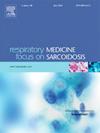评估重症和危重型COVID-19肺炎患者心外膜脂肪组织作为院内死亡率的预测因子
IF 3.5
3区 医学
Q2 CARDIAC & CARDIOVASCULAR SYSTEMS
引用次数: 0
摘要
导论:鉴于心血管疾病对COVID-19结局的影响,评估心外膜脂肪组织(EAT)等风险因素的兴趣越来越大。进食导致代谢综合征,通过炎症和胰岛素抵抗恶化心血管健康,并使COVID-19患者的死亡风险增加两倍。本研究考察了重症和危重型SARS-CoV-2肺炎患者的胃食管EAT体积(EATV)与临床结局之间的关系,并假设较高的胃食管EAT体积与严重程度和死亡率增加相关。方法:对750例COVID-19重症或危重型肺炎患者进行多中心回顾性队列研究,探讨EATV、肺严重程度指数(PSI)、Kirby指数与住院30天死亡率之间的关系。结果包括顺序器官衰竭评估、急性生理和慢性健康评估IV、Charlson合并症指数、Kirby指数、PSI和住院30天死亡率。本回顾性队列研究评估了EATV作为COVID-19死亡率的预后因素。结果:重症肺炎患者的EATV明显升高,并且与死亡率增加相关。EATV是院内死亡率最可靠的预测因子,截止值为117 cm3,表明风险较高。讨论:心外膜脂肪组织体积与重症和危重型肺炎患者的死亡率增加有关,特别是在第三阶段。它还与较高的肺部严重程度指数和30天住院死亡率有关。临床医生应考虑与炎症生物标志物一起使用EATV,以改善患者分层,并通过早期干预潜在地提高结果。本文章由计算机程序翻译,如有差异,请以英文原文为准。

Assessment of epicardial adipose tissue in patients with severe and critical COVID-19 pneumonia as a predictor of in-hospital mortality
Introduction
Given the impact of cardiovascular conditions on COVID-19 outcomes, there is increasing interest in assessing risk factors like epicardial adipose tissue (EAT). EAT contributes to metabolic syndrome, which worsens cardiovascular health through inflammation and insulin resistance, and triples mortality risk in COVID-19 patients. This study examined the relationship between EAT volume (EATV) and clinical outcomes in severe and critical SARS-CoV-2 pneumonia, hypothesizing that higher EATV would correlate with increased severity and mortality.
Methods
This multicenter retrospective cohort study of 750 COVID-19 patients with severe or critical pneumonia explored the relationships between EATV, the pulmonary severity index (PSI), the Kirby index, and 30-day in-hospital mortality. Outcomes included Sequential Organ Failure Assessment, Acute Physiology and Chronic Health Evaluation IV, Charlson comorbidity index, Kirby index, PSI, and 30-day in-hospital mortality. This retrospective cohort study evaluates EATV as a prognostic factor for COVID-19 mortality.
Results
EATV was significantly higher in patients with critical pneumonia and was also associated with increased mortality. EATV was the most robust predictor of in-hospital mortality, with a cut-off of 117 cm3 indicating a higher risk.
Discussion
Epicardial adipose tissue volume was linked to increased mortality in patients with severe and critical pneumonia, especially in the third tertile. It was also associated with higher pulmonary severity indices and 30-day in-hospital mortality. Clinicians should consider EATV alongside inflammatory biomarkers to improve patient stratification and potentially enhance outcomes through earlier intervention.
求助全文
通过发布文献求助,成功后即可免费获取论文全文。
去求助
来源期刊

Respiratory medicine
医学-呼吸系统
CiteScore
7.50
自引率
0.00%
发文量
199
审稿时长
38 days
期刊介绍:
Respiratory Medicine is an internationally-renowned journal devoted to the rapid publication of clinically-relevant respiratory medicine research. It combines cutting-edge original research with state-of-the-art reviews dealing with all aspects of respiratory diseases and therapeutic interventions. Topics include adult and paediatric medicine, epidemiology, immunology and cell biology, physiology, occupational disorders, and the role of allergens and pollutants.
Respiratory Medicine is increasingly the journal of choice for publication of phased trial work, commenting on effectiveness, dosage and methods of action.
 求助内容:
求助内容: 应助结果提醒方式:
应助结果提醒方式:


